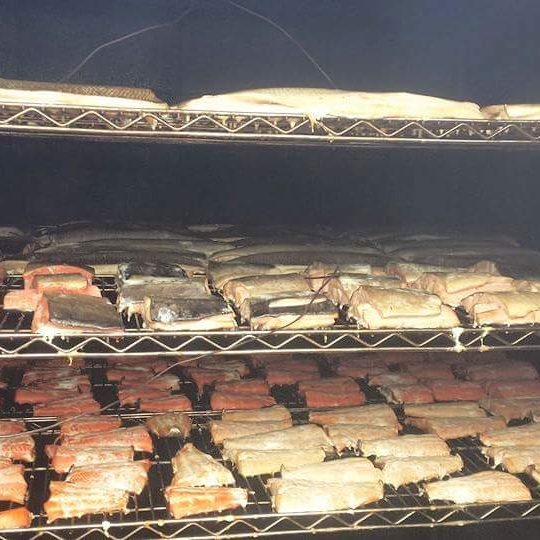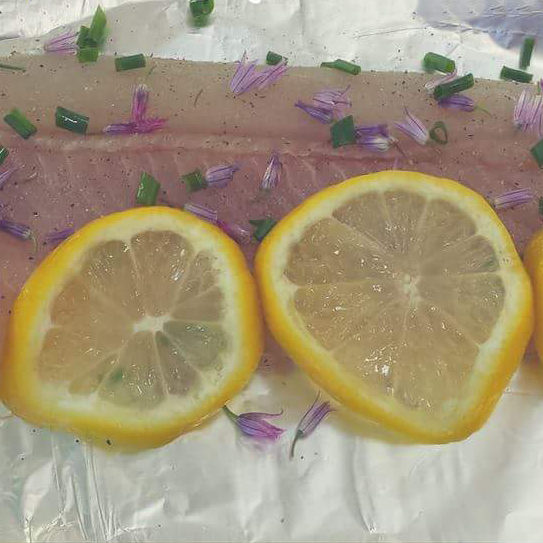

WE’VE PUT TOGETHER A SELECTION OF TERRIFIC RECIPES FOR YOU.
Your content goes here. Edit or remove this text inline or in the module Content settings. You can also style every aspect of this content in the module Design settings and even apply custom CSS to this text in the module Advanced settings.
Enjoy!
Search Recipes
handy tips & cooking
methods to try
Whether you’re new to cooking fish or an old pro Great Lakes Whitefish can be incredibly easy to fix. It’s fast, too! Especially when you purchase frozen fillets, you’re ready for a spur-of-the-moment fish dish.

Fish Glossary
CLEANING
Clean raw fish in preparation for cooking in the following manner.
1.Remove the head and carefully fillet the fish with a sharp, long-bladed knife, cutting along the backbone, belly and around the tail to end up with two “sides” of fish.
2. Trim the fat along the top center of each fillet.
3. Trim fat along edges.
DRESSED/PAN DRESSED
Dressed fish have been scaled, gutted, and had gills removed. Head and fins are intact. A dressed fish is often cooked in one piece by baking, poaching, or barbecuing. A pan-dressed fish has head, tail and fins removed as well.
FAT CONTENT
Most white-fleshed fish have lean, mild meat. Dark-fleshed fish tend to be oilier and more strongly flavored. Lean fish may require more oil in a recipe or more basting than a fattier fish cooked by the same method. You may bake, broil or barbeque fish on a rack to allow fat to drip off.
FILLETED
Fillets are the boneless or “pinbone-in” sides of a fish, cut away from the backbone and removed in one piece. In some fish, there may be pinbones radiating at right angles from the backbone. When these are removed, the fillet is boneless.
GUTTED
Gutted fish are whole fish that have internal organs removed and sometimes scaled with head and fins intact. A gutted fish has a longer storage life than a fish stored just as it comes from the water, because entrails cause rapid spoilage.
HERBS AND SPICES
Good seasonings for Whitefish include basil, bay leaves, celery salt, chervil, chives, dill, cinnamon, nutmeg, cayenne powder, garlic, fennel, curry, oregano, paprika, marjoram, rosemary, thyme, parsley, tarragon and saffron.
SAUCES
For fish, most commonly based with butter or margarine.
SEASONING
Whitefish are delicately flavored and delicious. Salt and a little butter, cream or lemon juice are all the seasoning you may want. Sauces used with Whitefish include mushroom, amandine (almond), hollandaise, mild cheese sauces and white wine.
STEAKED
Steaks are cross-sections cut from dressed fish. They are generally 1 to 2 inches thick. Large fish such as salmon, grouper, halibut and mackerel are often steaked.
STORING
Fresh Fish: Never keep raw fish longer than three days in the refrigerator
Frozen Fish: Store frozen Whitefish at 0 degrees F as follows:
Maximum Quality: up to 3 months
Maximum Storage: up to 9 months
Frozen Fish: Store frozen Whitefish at 0 degrees F as follows:
Maximum Quality: up to 3 months
Maximum Storage: up to 9 months
Prep Tips
IS IT DONE?
There are 3 simple ways to tell when your Great Lakes Whitefish fillets are fully cooked. First the flesh will be opaque. Second, when you insert a fork, the fish will pull apart into large flakes. Third, your fish will be “al dente” like spaghetti: slightly firm.
THAW
If your recipe calls for thawed fillets, defrost them in the refrigerator overnight. You can also defrost under cold running water or place in a bowl of cold water (change water every 30 minutes). If planning to cook immediately, fillets may be defrosted in the microwave on Defrost setting (should be icy but pliable).
STORE
Frozen fillets can stay in the freezer about 6 months. Defrosted fillets can be wrapped in plastic wrap and stored well chilled (32 degrees) for up to 2 days before use. Keep them in the coldest part of your refrigerator. To make sure fillets stay cold enough, wrapped fillets can be packed in ice in the fridge.
FROM FROZEN
Great Lakes Whitefish fillets may be baked, broiled or microwaved from frozen. Cook fish right from the freezer, before it starts to drip moisture. Simply bake or broil the fish longer at a slightly lower temperature. An extra 10 minutes for each inch of thickness should suffice.
BAKE
Great Lakes Whitefish fillets may be baked from frozen (see above) or thawed. Follow your recipe or bake at 350 degrees for 6-10 minutes per inch of thickest part of fillet.
BROIL
Great Lakes Whitefish fillets may be broiled from frozen (see above) or thawed. Follow your recipe or broil about 4-5 inches from heat for 6-12 minutes per inch of thickest part of fillet.
MICROWAVE
Great Lakes Whitefish fillets may be microwaved from frozen or thawed. Follow your recipe, or microwave frozen fillets for 4 minutes on High for each fillet. Cooking time will vary depending on thickness of fillet and oven model. Move to at least two spots in the microwave to ensure even cooking.
SAUTE
Follow your recipe, or use seasoning flour and breading in a hot skillet. Keeping the skin on helps hold the fillet together. To pan sear, dredge fillets in seasoned flour first, then in egg and next in breading. Use the “10 minutes per inch of thickness” rule of thumb.
GRILL
Follow your recipe or brush skin-on fillets lightly with oil and place on oiled grill or foil 2-4 inches from heat. Grill should be preheated to Medium High (white coals). Cook about 5 minutes for each 1/2-inch thickness of fillet; add about 3 minutes for each additional 1/2 inch.
DEEP FRY
Follow your recipe or dredge Great Lakes Whitefish fillets in seasoned flour then batter (cornmeal, flour, etc.). Fry in hot oil until golden brown. Note: pan sautéing suits Great Lakes Whitefish fillets better than deep frying.
POACH
Follow your recipe or place fillets in a seasoned liquid that has been brought to simmering, which means just below the boiling point. The liquid should at least cover the surface of the fillets. Timing is about 8 minutes per 1/2-inch thickness of fillet; add 2 minutes or so for each additional 1/2 inch of thickness.
STEAM
Follow your recipe, or season fillets and set onto a perforated steamer in a covered saucepot or in a bamboo steamer. Be sure cover is tight. Timing is approximately 3 minutes for 1/2-inch thick fillet; add about 4 minutes for each additional 1/2 inch.
PLANK
Pan dressed fish will require only 25-30 minutes to cook when planked. Fillets and steaks can also be planked.